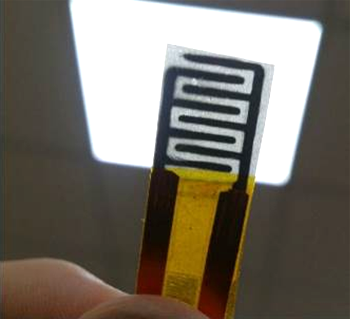Capacitive and resistive humidity sensors based on flexible nanocellulose film for wearable electronics
DOI:
https://doi.org/10.3103/S0735272722120019Abstract
The paper describes methods for obtaining nanocellulose from miscanthus stalks in an environmentally friendly way using the hydrolysis method. The nanocellulose parameters were investigated for applying the nanocellulose in capacitive and resistive humidity sensors. The influence of electrode system parameters and the operating frequency on sensor characteristics was investigated. It was established that the device sensitivity increases with the reduction of distance between electrodes and the operating frequency. Two models of sorption processes at the gas–solid interface were applied, namely, the Freundlich isotherm and Langmuir isotherm, for describing the mechanism of water adsorption by nanocellulose-based humidity sensors. The long-term operation stability of such devices was also investigated.
References
- H. S. Nishad, V. Sapner, B. M. Patil, B. R. Sathe, P. S. Walke, “Flexible and wearable electrochemical biosensors based on 2D materials,” in 2D Materials-Based Electrochemical Sensors, Elsevier, 2023, p. 432.
- S. Kwon, H. Kim, W. H. Yeo, “Recent advances in wearable sensors and portable electronics for sleep monitoring,” iScience, vol. 24, no. 5, p. 102461, 2021, doi: https://doi.org/10.1016/J.ISCI.2021.102461.
- Z. Tian et al., “Ultra-stable strain/humidity dual-functional flexible wearable sensor based on brush-like AgNPs@CNTs@TPU heterogeneous structure,” Colloids Surfaces A Physicochem. Eng. Asp., vol. 670, p. 131398, 2023, doi: https://doi.org/10.1016/j.colsurfa.2023.131398.
- V. Koval, V. Barbash, M. Dusheyko, V. Lapshuda, O. Yashchenko, A. Naidonov, “Nickel-based piezoresistive sensors obtained on flexible nanocellulose substrate,” in 2021 IEEE 11th International Conference Nanomaterials: Applications & Properties (NAP), 2021, pp. 1–5, doi: https://doi.org/10.1109/NAP51885.2021.9568610.
- Z. Xu et al., “A conducting polymer PEDOT:PSS hydrogel based wearable sensor for accurate uric acid detection in human sweat,” Sensors Actuators B Chem., vol. 348, p. 130674, 2021, doi: https://doi.org/10.1016/j.snb.2021.130674.
- S. J. Park, J. Y. Jeon, B. C. Kang, T. J. Ha, “Wearable temperature sensors based on lanthanum-doped aluminum-oxide dielectrics operating at low-voltage and high-frequency for healthcare monitoring systems,” Ceram. Int., vol. 47, no. 4, pp. 4579–4586, 2021, doi: https://doi.org/10.1016/J.CERAMINT.2020.10.023.
- H. Zhao, Z. Wang, Y. Li, M. Yang, “Single-sided and integrated polyaniline/ poly(vinylidene fluoride) flexible membrane with micro/nanostructures as breathable, nontoxic and fast response wearable humidity sensor,” J. Colloid Interface Sci., vol. 607, pp. 367–377, 2022, doi: https://doi.org/10.1016/j.jcis.2021.08.214.
- V. Koval et al., “Reactive ion beam sputtered molybdenum oxide thin films for optoelectronic application,” in 2020 IEEE 40th International Conference on Electronics and Nanotechnology (ELNANO), 2020, pp. 246–250, doi: https://doi.org/10.1109/ELNANO50318.2020.9088736.
- W. He, F. Xu, S. Lu, Y. Zhang, H. Fan, “Flexible and recoverable ion-conductive hydrogels with cross-linked triple network for highly sensitive wearable Motion-monitoring sensors,” Next Mater., vol. 1, no. 3, p. 100027, 2023, doi: https://doi.org/10.1016/j.nxmate.2023.100027.
- A. Orlov, V. Ulianova, A. Zazerin, O. Bogdan, G. Pashkevich, Y. Yakymenko, “Active elements on a basis of ZnO nanorods for energy harvesting devices,” Radioelectron. Commun. Syst., vol. 59, no. 2, pp. 60–65, 2016, doi: https://doi.org/10.3103/S0735272716020023.
- V. Koval, V. Barbash, M. Dusheyko, V. Lapshuda, O. Yashchenko, Y. Yakimenko, “Application of nanocellulose in humidity sensors for biodegradable electronics,” in 2020 IEEE 10th International Conference Nanomaterials: Applications & Properties (NAP), 2020, pp. 02NS01-1-02NS01-5, doi: https://doi.org/10.1109/NAP51477.2020.9309598.
- J. L. Eddaif, A. Shaban, “Fundamentals of sensor technology,” in Advanced Sensor Technology, Elsevier, 2022, p. 968.
- C. Zinge, B. Kandasubramanian, “Nanocellulose based biodegradable polymers,” Eur. Polym. J., vol. 133, p. 109758, 2020, doi: https://doi.org/10.1016/J.EURPOLYMJ.2020.109758.
- V. Lapshuda, V. Koval, V. Barbash, M. Dusheiko, O. Yashchenko, S. Malyuta, “Flexible humidity sensors based on nanocellulose,” in 2022 IEEE 41st International Conference on Electronics and Nanotechnology (ELNANO), 2022, pp. 208–212, doi: https://doi.org/10.1109/ELNANO54667.2022.9927092.
- A. Naidonov, V. Koval, V. Barbash, M. Dusheiko, O. Yashchenko, O. Yakymenko, “Nanocellulose-based biodegradable bend sensors,” in 2022 IEEE 41st International Conference on Electronics and Nanotechnology (ELNANO), 2022, pp. 292–297, doi: https://doi.org/10.1109/ELNANO54667.2022.9927070.
- V. A. Barbash, O. V. Yashchenko, O. A. Vasylieva, “Preparation and properties of nanocellulose from miscanthus x giganteus,” J. Nanomater., vol. 2019, pp. 1–8, 2019, doi: https://doi.org/10.1155/2019/3241968.
- V. M. Koval et al., “Application of nanostructured silver film in multilayer contact system of Ti/Mo/Ag silicon photoconverters,” Radioelectron. Commun. Syst., vol. 59, no. 2, pp. 53–59, 2016, doi: https://doi.org/10.3103/S0735272716020011.
- S. Xu, W. Yu, X. Yao, Q. Zhang, Q. Fu, “Nanocellulose-assisted dispersion of graphene to fabricate poly(vinyl alcohol)/graphene nanocomposite for humidity sensing,” Compos. Sci. Technol., vol. 131, pp. 67–76, 2016, doi: https://doi.org/10.1016/j.compscitech.2016.05.014.
- X. Li et al., “Facile fabrication of laser-scribed-graphene humidity sensors by a commercial DVD drive,” Sensors Actuators B Chem., vol. 321, p. 128483, 2020, doi: https://doi.org/10.1016/j.snb.2020.128483.
- H. Li, J. Zhang, B. Tao, L. Wan, W. Gong, “Investigation of capacitive humidity sensing behavior of silicon nanowires,” Phys. E Low-dimensional Syst. Nanostructures, vol. 41, no. 4, pp. 600–604, 2009, doi: https://doi.org/10.1016/j.physe.2008.10.016.
- A. Kumar, G. Gupta, K. Bapna, D. D. Shivagan, “Semiconductor-metal-oxide-based nano-composites for humidity sensing applications,” Mater. Res. Bull., vol. 158, p. 112053, 2023, doi: https://doi.org/10.1016/j.materresbull.2022.112053.
- R. Kecili, C. M. Hussain, “Mechanism of adsorption on nanomaterials,” in Nanomaterials in Chromatography, Elsevier, 2018, pp. 89–115.
- A. O. Dada, “Langmuir, Freundlich, Temkin and Dubinin–Radushkevich Isotherms studies of equilibrium sorption of Zn 2+ unto phosphoric acid modified rice husk,” IOSR J. Appl. Chem., vol. 3, no. 1, pp. 38–45, 2012, doi: https://doi.org/10.9790/5736-0313845.
- B. Tao, J. Zhang, F. Miao, H. Li, L. Wan, Y. Wang, “Capacitive humidity sensors based on Ni/SiNWs nanocomposites,” Sensors Actuators B Chem., vol. 136, no. 1, pp. 144–150, 2009, doi: https://doi.org/10.1016/j.snb.2008.10.039.


